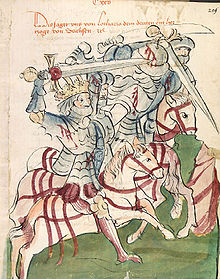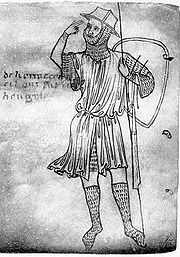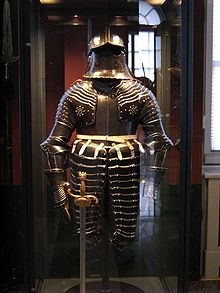
Poleyn
Encyclopedia

Renaissance
The Renaissance was a cultural movement that spanned roughly the 14th to the 17th century, beginning in Italy in the Late Middle Ages and later spreading to the rest of Europe. The term is also used more loosely to refer to the historical era, but since the changes of the Renaissance were not...
armor that protected the knee. During the transition
Transitional armour
Transitional armour describes the armour used in Europe around the 14th century, as body armour moved from simple maille hauberks to full plate....
from mail
Chainmail
Mail is a type of armour consisting of small metal rings linked together in a pattern to form a mesh.-History:Mail was a highly successful type of armour and was used by nearly every metalworking culture....
armor to plate armor, this was among the earliest plate components to develop. They first appeared in the mid-thirteenth century and remained in use until the early seventeenth century when firearms made them obsolete. They hung from the Fauld.
The specifics of poleyn design varied considerably over that period. The earliest poleyns were strapped over mail chausses
Chausses
Chausses are armour for the legs, usually made from mail. They could extend to the knee or cover the entire leg. Chausses were the standard type of metal leg armour during most of the European Middle Ages. Chausses offered flexible protection that was effective against slashing weapons...
. Late fourteenth century and early fifteenth century poleyns usually attached to padded leggings with leather buckles and incorporated gousset
Gousset
Gousset was a component of late Medieval armor. During the transition from mail to plate armor, sections of mail covered parts of the body that were not protected by steel plate. These sections of mail were known as gousset. Gousset came into use in the fourteenth century as plate became a...
s. During the fifteenth century poleyns developed an articulated construction that attached to the cuisses
Cuisses
Cuisses are a form of medieval armor worn to protect the thigh. The word is the plural of the French word cuisse meaning 'thigh'. While the skirt of a maille shirt or tassets of a cuirass could protect the upper legs from above, a thrust from below could avoid these defenses. Thus, cuisses were...
and schynbalds
Schynbalds
Schynbalds were an early experiment in plate armour for the lower leg. Schynbalds were metal plates strapped over chausses. Each schynbald was a single piece of steel that covered the front and outside of the shin. Schynbalds did not enclose the lower leg: hence, they were not true greaves...
or greave
Greave
A greave is a piece of armour that protects the leg.-Description:...
s. A characteristic of late fifteenth century gothic armor was a projection that guarded the side of the knee.


External links
- The Poleyn instructions for creating reproduction sixteenth century poleyns
- Leg Harness (1400 - 1620) description of historic developments in leg armor

